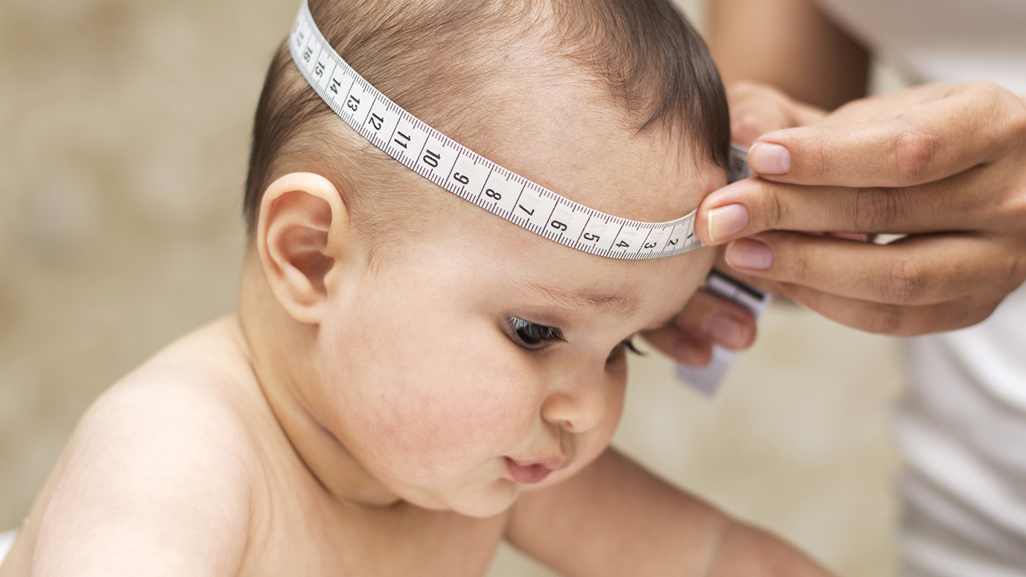The measurement of your baby's head is important because the size of her skull over time reflects the growth of her brain.
To check your baby's head size, doctors measure the head circumference (HC). This is a measurement of your baby's head around its largest area.
Advertisement | page continues below
If your baby's head is not growing along the expected growth curve for their age, it might mean the brain isn't growing as it should. This alerts your doctor to certain medical or developmental problems.
How will the size of my baby's head be measured?
To measure your baby's head, the doctor or nurse places a flexible measuring tape where your baby's head has the largest circumference. This is just above the eyebrows and ears, and around the back of the head, where it slopes up prominently from the neck. Doctors call it a fronto-occipital circumference (or OFC).
This measurement is then recorded in your baby's
growth chart, along with her length and weight.
Measuring your baby's head circumference is a simple, easy and non-invasive way for your doctor to see that all is well with your baby's brain development.
How often will my baby's head circumference be measured?
Your doctor will measure your baby's head circumference at each monthly check-up.
Measuring a baby's head circumference is an essential part of tracking your baby's growth and the development of the central nervous system.
The first time your baby's head will be measured is shortly after birth. At birth, your baby's head is 25 per cent of its future adult size, and by age 3, the brain is 80 per cent of its adult size.
Because birth to 3 years old is a period of rapid brain growth, your child's doctor will measure your baby's head circumference at every monthly visit during your baby's first year. He'll continue measuring your baby's head at regular appointments till 2 years old.
Advertisement | page continues below
Each time a measurement is taken, your baby's doctor will compare the measurement with your baby's past measurements, and the normal ranges for your child's gender and age.
If your doctor thinks your baby's head is growing too fast or too slow, he's likely to suggest more frequent visits so he can monitor things more closely.
Head circumference is also measured in older children if your doctor suspects there is a problem.
What is a normal head circumference for babies?
There's no one fixed number to define a normal baby head circumference at a given age. Most doctors use charts developed by the World Health Organization (WHO) that provide ranges.
These charts give the average head circumference for a boy or girl at a given age, and they allow your baby's doctor to compare your baby's head size with the average – as well as with your baby's growth over time. The normal range is usually defined as approximately between the 3rd to 97th percentiles.
Advertisement | page continues below
So, if your baby's head circumference is in the 50th percentile, that means she has the average head circumference for her age. If her number is in the 30th percentile on the chart, it means that 30 per cent of babies the same age have that same head circumference, and 70 per cent have a larger head circumference.
To know more about what growth charts and percentile curves mean, and how they are used, take a look at our article on
growth charts: understanding the results.
When should I be concerned about my baby's head size?
At birth, if your baby's head is unusually disproportionate to the rest of your baby's body, and your baby's head circumference is outside of the normal range of measurements for a newborn, your doctor might want to check for a health problem that could be causing this. A smaller than normal head is a condition known as microcephaly. If your baby's head is larger than normal, the condition is known as macrocephaly.
Babies' heads are usually disproportionate compared to their bodies. They often have big heads and small bodies. So your doctor won't be concerned unless the disproportion is out of what is considered normal. The size of your baby's head also depends on their genes. If you or your husband have a large or small head, your baby might, too.
As your baby grows, if there is a deviation from the expected growth curve of your baby's head circumference over time, it could mean that there is a problem with how your baby's brain is growing. That's why it's essential to go for all the scheduled baby check-ups, so that any problems can be picked up early.
If you have questions about your baby's head size or development, don't hesitate to talk to your doctor. He can check your baby and offer you advice and reassurance.
Should I worry if my baby's head circumference is smaller than average?
On its own, having a small head is not a sign of a problem. You shouldn't be worried about your baby's health if their head circumference is on a lower percentile. Your doctor will only be concerned by this if:
- over time your baby's head doesn't grow as expected. This means that the circumference measurements keep dropping percentile lines as your baby grows.
- your baby doesn't meet their milestones as expected. Not meeting milestones in time, along with lower than expected growth of the head, can indicate a developmental problem.
Advertisement | page continues below
Your baby's doctor will want to investigate further. You will probably be referred to a paediatric neurologist or neurosurgeon if your baby has
microcephaly (small head size).
Should I worry if my baby's head circumference is larger than average?
On its own, a larger than average head is not a problem. Your baby's height and body size is after all determined by their genes, and your baby might have relatives with a big head.
Your baby's doctor will only be concerned if:
- your baby's head is much larger than the range (not average) of normal for her age, or;
- your baby's head grows faster than expected over time;
- your baby also has other health problems that combined with a larger than normal head could indicate a condition.
A larger-than-expected head size may be a sign of hydrocephalus, which is a build-up of fluid in and around the brain. This rare condition can increase the pressure in your baby's head. Other causes of a large head size are brain tumours or genetic disorders.
Again, you'll be referred to a paediatric neurologist or neurosurgeon who can diagnose and treat the condition.
Advertisement | page continues below
Baby and toddler head circumference charts
If you'd like to know what's considered the normal range of head circumference measurements, take a look at the following:
Head circumference charts for girls Head circumference charts for boys Do I need to measure my baby's head circumference at home?
It's not usually needed for you to measure your baby's head circumference at home, especially if you're taking your baby for her scheduled check-ups. Still, some parents like to track their baby's length, weight, and head circumference between visits.
So if you want to measure her head, here's how to do it:
- Get your baby in a comfortable position. It's useful to have someone with you who can hold your baby while you take the measurements.
- Wrap a flexible, non-stretchable measuring tape around your baby's head at the widest part – above the eyebrows and ears, and around the back where the head slopes up prominently from the neck.
- Be careful not to pull the measuring tape too tight.
- The goal is to measure your baby's head at the spot where it has the largest circumference.
- Take the measurement three times and choose the largest measurement to the nearest 0.1 cm.
- Record the reading in a notebook, or a growth tracker app on your phone if you're using one.
Advertisement | page continues below
यह लेख हिंदी में पढ़ें:
बच्चे के सिर का माप इतना महत्वपूर्ण क्यों होता है? Read more on: 


